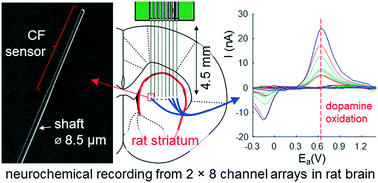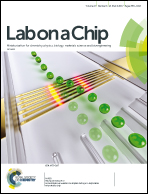Subcellular probes for neurochemical recording from multiple brain sites†
Abstract
Dysregulation of neurochemicals, in particular, dopamine, is epitomized in numerous debilitating disorders that impair normal movement and mood aspects of our everyday behavior. Neurochemical transmission is a neuron-specific process, and further exhibits region-specific signaling in the brain. Tools are needed to monitor the heterogeneous spatiotemporal dynamics of dopamine neurotransmission without compromising the physiological processes of the neuronal environment. We developed neurochemical probes that are ten times smaller than any existing dopamine sensor, based on the size of the entire implanted shaft and its sensing tip. The microfabricated probe occupies a spatial footprint (9 μm) coordinate with the average size of individual neuronal cells (∼10 μm). These cellular-scale probes were shown to reduce inflammatory response of the implanted brain tissue environment. The probes are further configured in the form of a microarray to permit electrochemical sampling of dopamine and other neurotransmitters at unprecedented spatial densities and distributions. Dopamine recording was performed concurrently from up to 16 sites in the striatum of rats, revealing a remarkable spatiotemporal contrast in dopamine transmission as well as site-specific pharmacological modulation. Collectively, the reported platform endeavors to enable high density mapping of the chemical messengers fundamentally involved in neuronal communication through the use of minimally invasive probes that help preserve the neuronal viability of the implant environment.



 Please wait while we load your content...
Please wait while we load your content...